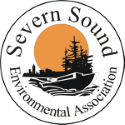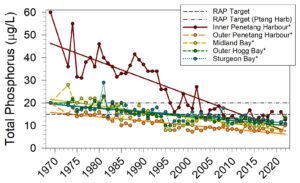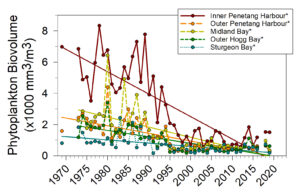Severn sound Open Water
Background
In the past, Severn Sound experienced excessive phosphorus enrichment. This resulted in excessive algae growth, leading to poor water quality conditions for recreational uses such as swimming, and low oxygen conditions for cold water fish communities. In 1985, Severn Sound was listed as an Area of Concern (AOC), one of the most polluted on the Great Lakes. Led by Environment Canada and the Ministry of the Environment, the communities surrounding Severn Sound developed a Remedial Action Plan (RAP), the goals of which were to improve water quality and restore a healthy ecosystem in Severn Sound.
Implementation of the RAP resulted in reduced phosphorus loads through sewage treatment plant upgrades, agricultural projects, private sewage system upgrades, and stormwater treatment. This in turn led to significant improvement in the water quality of the Sound. In 2003, restoration targets had been met, and Severn Sound was delisted as an AOC. The RAP continued as the Severn Sound Environmental Association (SSEA), which monitors 14 stations throughout the Sound in an effort to detect long-term changes in water quality. SSEA continues to monitor water quality and work with municipal partners to ensure that the quality of Severn Sound is maintained.
Monitoring in the open waters of Severn Sound began in 1973 by the Ontario Ministry of Environment. Five stations were regularly sampled – one in each bay of Severn Sound, and one in the open waters. In 1997, the Severn Sound Environmental Association (formerly the Severn Sound Remedial Action Plan) took over regular monitoring, which continues today. The Severn Sound RAP Stage 3 Report called for continued monitoring of Severn Sound in order to assess changes in trophic status in relation to remedial actions and other ecosystem changes in the area (e.g. invasive species, water level changes).
Factors Affecting Water Quality
Severn Sound is a dynamic system that is influenced on a regional scale by the entire Great Lakes system (e.g. introduction of invasive species like zebra and quagga mussels (Dreissena spp) and spiny water flea (Bythotrephes), climate change, fluctuating water levels), and on a local scale by its surrounding watershed (point and non-point additions of nutrients and other contaminants).
TRENDS
Severn Sound Water Quality and Lower Food Web:
NUTRIENTS:
Phosphorus concentrations have decreased below the target of 15 µg/L for Severn Sound and 20 µg/L for Penetang Harbour, set in the Remedial Action Plan. Reduced phosphorus loads from upgrades to sewage treatment plants, agricultural stewardship projects, private system upgrades and stormwater treatment have played an important role in reducing nuisance algae growths and restoring the water quality of Severn Sound.
Spring concentrations of nitrate, the form of nitrogen most available to algae, are highly variable but have been increasing in Midland Bay and inner Penetang Harbour since 1970. Following spring melt, concentrations decline rapidly as nitrate is taken up by plants and algae, so spring levels are a better indicator of watershed sources. However, since phosphorus concentrations have declined and it is the limiting nutrient, increased levels of nitrate are unlikely to lead to increased algal biomass of most types of algae. Increased nitrate in some parts of the Great Lakes has been linked to increases in blue green algae blooms. Ammonia concentrations are low in Severn Sound and have fluctuated around a fairly consistent level.
TEMPERATURE:
The average May-October temperature at 1m below surface has increased at all long term stations across Severn Sound. The rate of increase on average is 0.4°C per decade. Looking at October temperatures, that rate of increase doubles to 0.8°C per decade. Higher fall temperatures can lead to delayed ice-up, and have been linked to increased blue green algae growth the following season.
DISSOLVED OXYGEN:
The annual average concentration of dissolved oxygen has increased at all long term stations, and indicates an improvement in water quality conditions. Over the last 10 years, the RAP targets have been met, with the occasional exception of Midland Bay and Outer Hogg Bay.
WATER CLARITY:
The RAP target levels of 3 m for Severn Sound and 2 m for Penetang Harbour are mostly being met, with occasional exceedances in Midland Bay, and frequent exceedances in Outer Hogg Bay. The large and rapid increase in clarity around 1994 coincides with the zebra mussel invasion, as well as several major upgrades to sewage treatment plants that discharge to Severn Sound. A decrease in clarity across Severn Sound since the mussel invasion may be related to changing algae communities.
Chlorophyll a:
This pigment is found in both plants and algae. Concentrations in water are related to the amount of algae in the water column. There is a gap in data from 2009-2020 for most stations, however recent data shows that concentrations are meeting RAP target levels of 5 µg/L for Severn Sound and 7 µg/L for Penetang Harbour. Over the entire monitoring period, chlorophyll a concentrations have decreased, indicating a decline in algae.
ALGAE (Phytoplankton):
Algae biomass is measured as cell volume, also known as biovolume. All long term stations have shown a decrease in the total biovolume of algae. Since the zebra mussel invasion, biovolume levels have remained fairly stable.
ZOOPLANKTON:
Despite normal annual fluctuations, the number of zooplankton species, or diversity, has increased, which is a good sign. However, total densities have declined in recent years for reasons that are unclear at this time, and may be related to regional stressors.










